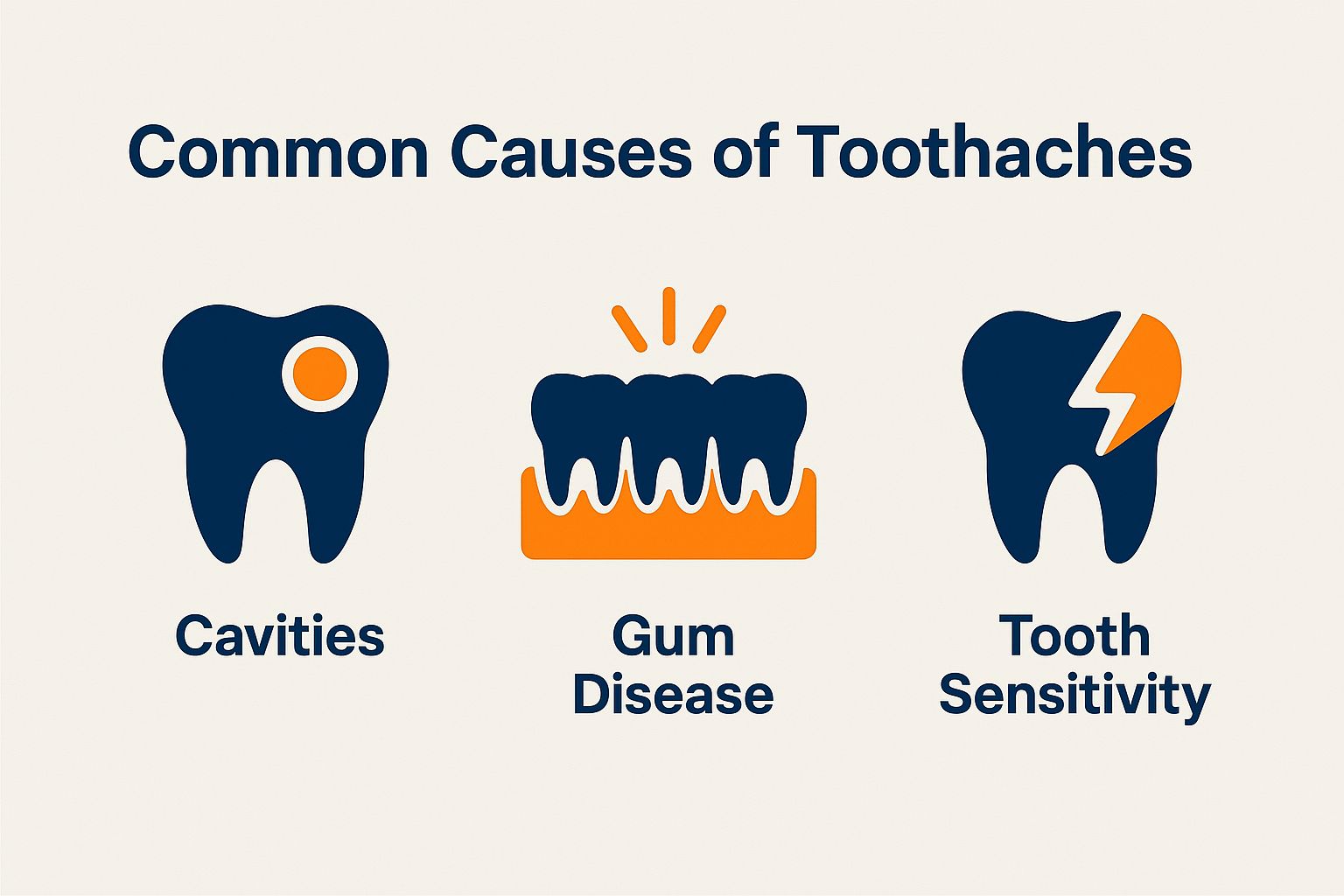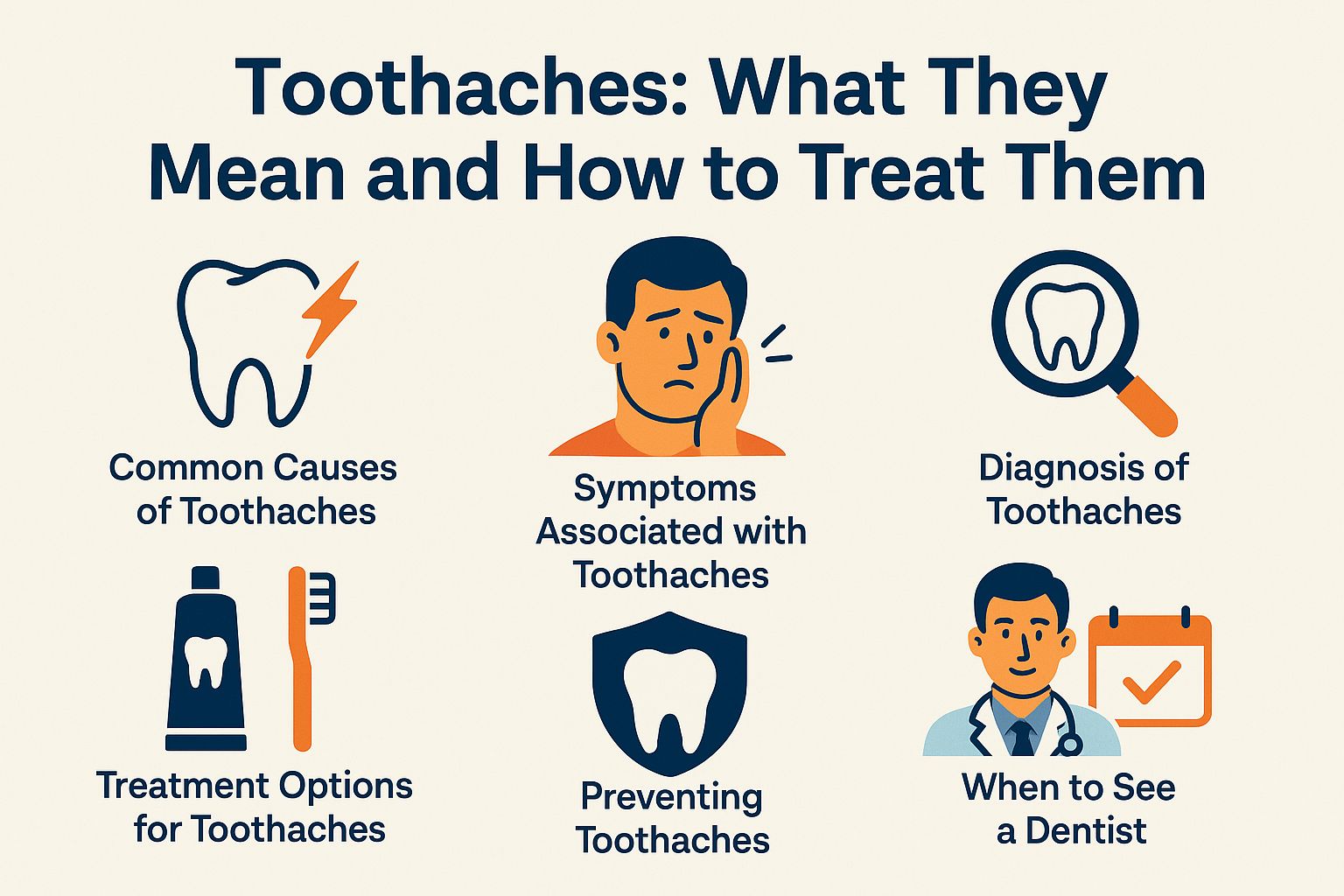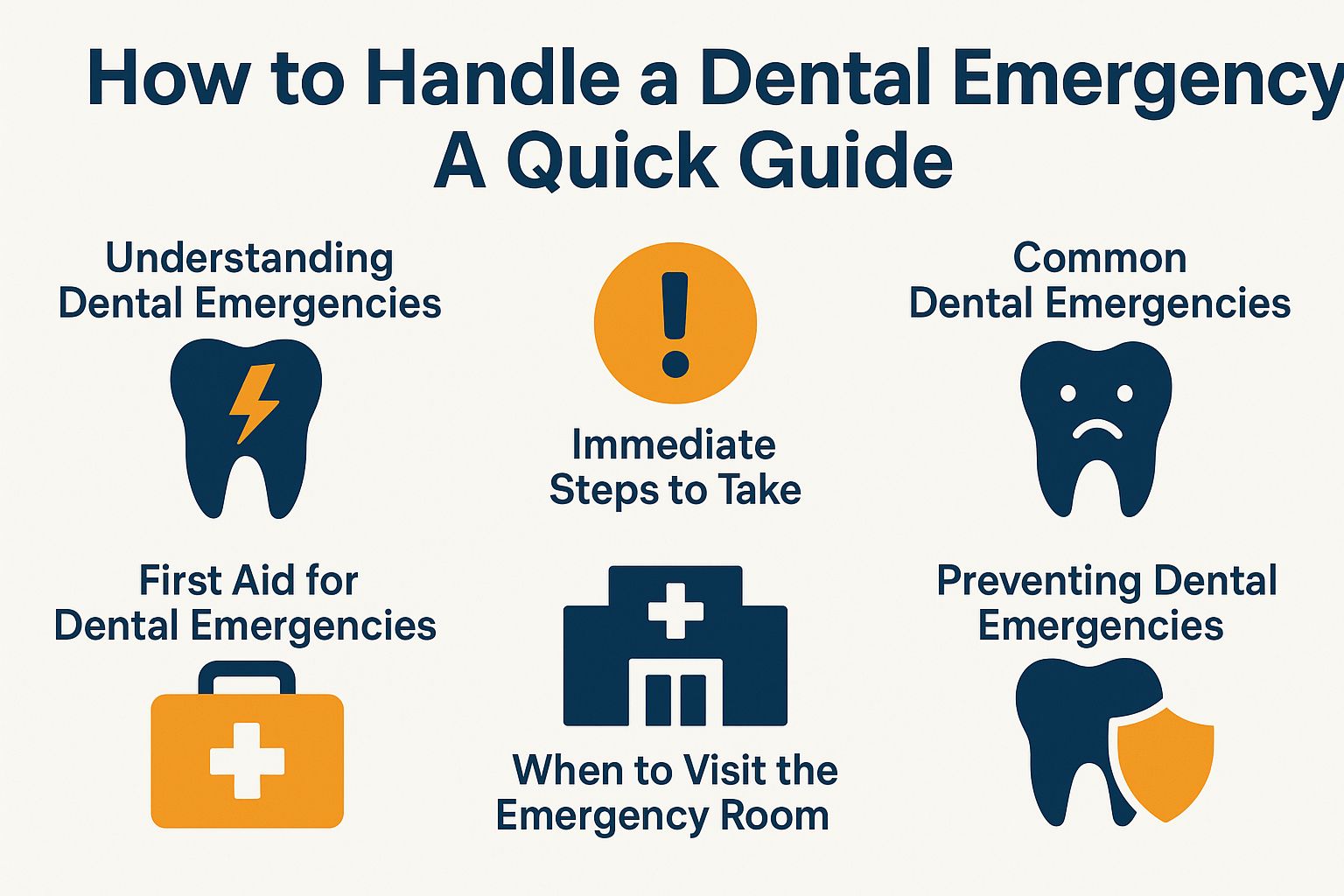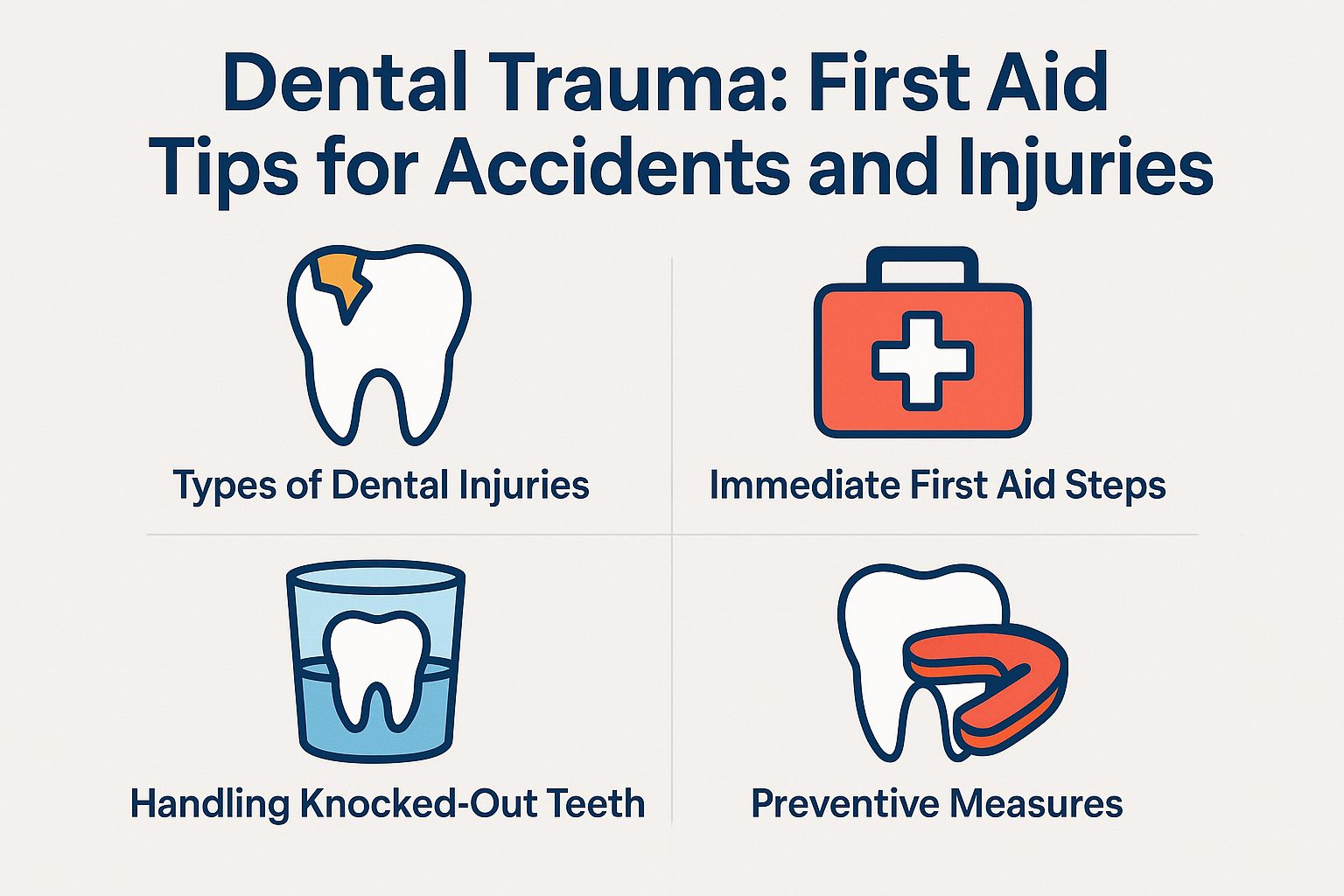Toothaches can signal dental issues like cavities or swollen gums. You might need effective pain relief or even a visit to an emergency dentist. Understanding the causes of toothaches is essential for oral health. You may consider home remedies like salt water rinses or seek professional treatment. This article explores common causes and symptoms of toothaches. It covers effective treatments, including painkillers like acetaminophen and ibuprofen, and when to consult a dentist.
Common Causes of Toothaches
Understanding common causes of toothaches helps with early diagnosis and treatment. This can prevent further dental issues and improve oral health.

Cavities
Cavities, which result from tooth decay, impact nearly 91% of adults and are a primary cause of toothaches. Tooth decay occurs when plaque, a sticky film composed of bacteria, accumulates on the teeth, leading to dental abscess and other complications. These bacteria produce acids that erode tooth enamel.
Fluoride toothpaste plays a vital role in the prevention of tooth decay by re-mineralizing enamel, thereby enhancing its resistance to acid attacks.
Research shows that visiting the dentist at least twice a year can lower the risk of cavities and other dental issues significantly.
Regular dental check-ups are essential, as they facilitate the early detection and treatment of decay, preventing the need for more invasive dental treatment.
Research indicates that individuals who visit the dentist at least twice a year can significantly lower your risk of cavities and other dental issues. Furthermore, maintaining proper oral hygiene through daily brushing and flossing can help mitigate plaque buildup, contributing to the overall health of one’s smile.
Gum Disease
Gum disease, which affects approximately 50% of adults over the age of 30, can result in toothaches due to inflammation and infection, often requiring antibiotics for treatment.
Gum disease starts with gingivitis, which causes swollen and bleeding gums.
The progression of gum disease begins with gingivitis, a condition characterized by swollen and bleeding gums. If left untreated, it can advance to periodontitis, where the supporting bone structure deteriorates, leading to significant pain and increased tooth mobility.
To prevent gum disease, maintain good oral hygiene by following these tips:
- Brushing twice daily with fluoride toothpaste,
- Flossing daily to remove plaque from between teeth, and
- Visiting a dentist regularly for professional cleanings.
Additionally, adhering to a balanced diet low in sugar can significantly reduce the risk of developing gum disease.
Tooth Sensitivity
Tooth sensitivity affects about 40 million adults in the U.S. It often causes sharp pain when eating hot or cold foods and may indicate sensitive teeth.
Common causes of tooth sensitivity include worn enamel, gum recession, and cavities. To manage this discomfort, individuals may consider using desensitizing toothpaste, such as Sensodyne, which aids in blocking pain signals to the nerves.
It is advisable to limit the intake of acidic foods, including citrus fruits and soda, as they can further contribute to enamel erosion. Regular dental check-ups are also essential; a dentist can recommend protective treatments or fluoride varnishes to enhance enamel strength.
By implementing these strategies, individuals can significantly reduce sensitivity and improve their overall dental health.
Symptoms Associated with Toothaches
Recognizing toothache symptoms allows for prompt treatment and better oral health outcomes.

Pain Types
Toothache pain varies greatly. It can be sharp and shooting or dull and persistent, depending on the cause. Sharp, shooting pain typically indicates conditions such as cavities or nerve damage, whereas dull, throbbing pain may be associated with gum disease.
For quick relief, you can use over-the-counter pain relievers such as:
- Ibuprofen (200-400 mg every 6-8 hours)
- Acetaminophen (500-1000 mg every 4-6 hours)
These medications can effectively manage symptoms. Additionally, applying a cold compress to the exterior of the cheek for 15-20 minutes can assist in reducing swelling and numbing discomfort until a consultation with a dentist can be arranged for a proper diagnosis and treatment.
Swelling and Inflammation
Swelling in the gums or face often indicates a toothache and may suggest the presence of an infection or gum disease. This swelling can affect comfort and oral health, necessitating prompt medical attention to prevent potential complications.
To ease discomfort at home, use salt water rinses.
To ease discomfort at home, start with salt water rinses. This involves dissolving half a teaspoon of salt in a glass of warm water and swishing the solution for approximately 30 seconds. Additionally, applying ice packs externally can help reduce swelling.
If swelling intensifies or symptoms like fever or difficulty breathing occur, it is imperative to seek dental treatment immediately. These symptoms could signify a severe infection that requires professional intervention, which may include the administration of antibiotics or drainage procedures.
Diagnosis of Toothaches
A comprehensive diagnosis of toothaches generally requires a combination of patient history, physical examination, and diagnostic imaging.
The dentist typically commences the process by collecting detailed patient history, inquiring about the nature and duration of the pain. This is subsequently followed by a visual examination to identify any apparent issues, such as cavities or gum inflammation.
Diagnostic imaging, including X-rays, is then utilized to uncover underlying problems, such as decay situated deep within the tooth or impacted wisdom teeth. In certain instances, pulp vitality tests may be conducted to evaluate the health of the tooth’s nerve.
Timely dental check-ups are essential, as early diagnosis can avert more severe dental complications.
Treatment Options for Toothaches
Treatment options for toothaches vary based on the cause and pain severity.

Quick Home Remedies
Home Remedies for Quick Relief
Home remedies can offer temporary relief for toothaches, with many individuals utilizing options such as salt water rinses, hydrogen peroxide rinses, and clove oil applications.
Mix a teaspoon of salt in a glass of warm water for rinses. It is recommended to swish the solution around the mouth for approximately 30 seconds before spitting it out, as this can help reduce inflammation and cleanse the affected area.
Clove oil, recognized for its numbing properties, may be applied directly to the affected tooth using a cotton ball. While these remedies can provide effective immediate pain relief, they do not address underlying dental issues.
Therefore, consult a dentist for any persistent pain.
Professional Dental Treatments
Professional dental treatments address underlying issues. These may include fillings, root canals, or prescription antibiotics.
Dental fillings are typically recommended for cavities and generally cost between $100 and $300, with the procedure completed in a single visit. Root canals, which are necessary for treating infected teeth and preventing dental abscess, can range from $700 to $1,500 and usually require two appointments to complete. The cost of antibiotic prescriptions varies depending on the specific medication, typically falling within the range of $10 to $50.
These treatments aim to relieve pain and prevent further damage to your teeth.
Each of these treatments is aimed at alleviating pain and preventing further damage to the teeth. Recovery times can vary, ranging from a few hours to a couple of days, depending on the specific procedure performed. Patients should anticipate follow-up care and may need to make lifestyle adjustments post-treatment to ensure optimal healing.
How to Prevent Toothaches
Preventing toothaches is achievable through consistent dental care and the adoption of healthy habits that promote oral health.
Brush your teeth twice daily with fluoride toothpaste, like Colgate Total or Crest Pro-Health. These products strengthen enamel and prevent tooth decay.
Maintaining a balanced diet rich in vitamins and minerals is crucial for strong teeth. Focus on calcium and vitamin D, which are abundant in dairy products and leafy greens.
Early intervention is key. Addressing dental issues before they escalate can prevent painful toothaches.
When to See a Dentist
Knowing when to see a dentist helps you manage toothache pain effectively.
If you experience prolonged or severe pain, schedule an appointment with a dentist immediately.
Swelling around the gums or jaw, especially with a fever, may indicate an infection. This requires immediate medical attention, possibly at the emergency room.
If you notice unusual changes like persistent bad breath or a bad taste in your mouth, contact a dentist right away.
Regular self-assessments and dental cleanings help identify issues early. This significantly reduces the need for emergency visits.




